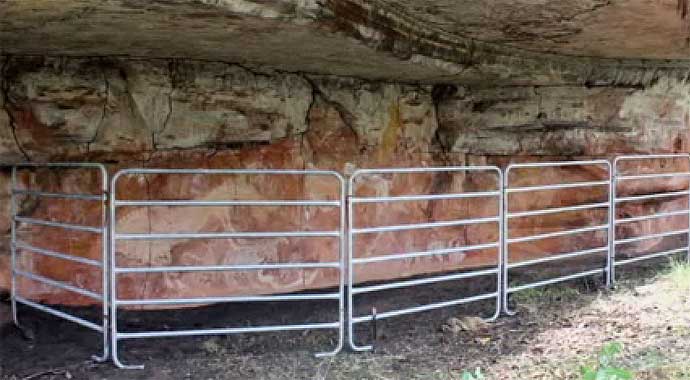Thousands of Arnhem Land rock paintings are under threat from buffalo, fire and feral animals
The Northern Territory's Arnhem Land plateau – a vast expanse of rock formations – has more paintings amongst its myriad of rock shelters than perhaps anywhere else on the planet. However, there is constant damage done to the paintings by fire and feral animals, specifically wild buffalo.
 Cattle barriers set up to protect paintings from Buffalo (see video below)
Cattle barriers set up to protect paintings from Buffalo (see video below)Tim Lee ABC Landline 5 October 2014
Experts estimate the number of rock art sites is in the thousands, but a full survey has not been done.
The region is simply so large and so remote. There are next to no roads and no local inhabitants.
The last indigenous clans moved down from the plateau in the 1960s, lured away from their traditional lifestyle by Western luxuries such as flour and tobacco.
But in their art, intricately daubed in ochre pigments, they left a remarkable record of their everyday life.
There are depictions of fauna and spirits and cryptic figures whose meaning is lost in time. Some of the art is estimated to be 50,000 years old.
Most striking however are the relatively recent images of the arrival of Europeans in the country.
There are depictions of explorers, such as the ill-fated Ludwig Leichardt, who crossed the plateau on horseback in late 1845.
We know the date because Leichardt wrote about his wretched ordeal there in his diary.
(ABC Landline Report)
In a rock shelter about 60 kilometres east of Jabiru he is seen overhead in a painting that is almost life-sized.
The artist who recorded his passing was a keen observer – the horse is seen wearing a leather breastplate, Leichardt's attempt to stop his horses being staked in dangerous scrubby country.
You would imagine that isolation of this art would keep it safe from vandalism or from threats such as mining leases.
But in this case the lack of people on the plateau has left much of it imperilled.
"The rock art is globally significant, but it has conservation problems to do with the effects of buffalo, feral animals ... fire and vegetation that rubs against rock paintings," said Peter Cooke of the Warddeken Indigenous Protection Area.
Wild buffalos using rock caves for shelter
Feral buffalo and wild cattle also use the rock galleries for shelter.
They can rub against delicate art works and pulverize valuable artefacts left on the ground.
As the traditional clans gradually moved from the plateau, the intricate pattern of fuel reduction burning was lost.
These days much of the bush is thicker. Wild fires that burn hotter can crack and destroy sandstone rock galleries.
Vegetation can sprout close to art sites and erase priceless paintings.
The so-called first contact art is often most at risk, because the artists used pigments that were less resilient than the older paintings.
Traditional owner Fred Hunter of the Bolmo clan said his ancestors must have marvelled at the arrival of these aliens into their world and used art to convey the drama of what they had seen.
"For the first time seeing a person riding a horse – they've probably never ever seen this animal before – it would have been a big shock, a big culture shock, I'd imagine," Mr Hunter said.
The Warddeken Rangers, a local group formed to manage traditional country, is helping protect and preserve these priceless paintings.
In some areas, they have erected portable fences to exclude cattle and buffalo from rock shelters.
Every dry season the rangers carry out extensive and systematic fuel reduction burning.
In recent times, with the backing of traditional owners, Mr Cooke has led a campaign to highlight the existence of Arnhem Land rock art and convey the challenge of preserving it.
He has had many of the first contact paintings recorded and photographed and has mounted a travelling exhibition, recently shown in Melbourne.
Mr Cooke said he hopes to take the exhibition around the country.
"It's quite a wonderful slice of our history that I think many people aren't aware of," said Darwin-based photographer David Hancock, who took the photographs for the exhibition.
"These rock art drawings mean a lot to indigenous people but, really, in the context of history they mean a lot to us too."
Not enough being done to protect works: art conservator
For traditional owners such as Mr Hunter, the art is a means of reconnecting with their ancestral country.
"We've got people walking back on country now, you know," he said.
"They're walking through their own country and their burning and their finding art sites like this and they're looking after it, they're recording it.
"Most of the old people that talked about it, [who had] seen it when they were young, they're all passing on now. You need the younger generation, getting back on country, looking after country. Especially art sites like this."
Art conservator Bruce Ford said he fears not enough is being done to protect the works.
He said it would take many years and many millions of dollars to safeguard the rock art.
"That kind of systematic recording and then condition recording hasn't been done in Australia on a large scale and I think that's the next frontier," Mr Ford said.
"Australia has been a pioneer in rock art conservation, mostly because of funding programs administered by the Aboriginal and Torres Strait Islander Studies organisation. But that funding finished about 15 years ago and, since then, there's been no consistent funding for this sort of work.
"The range of challenges is huge. "

